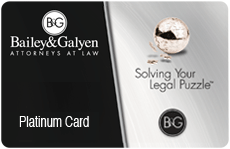What Is the Legal Basis for a Personal Injury Claim?
 When you’ve suffered any type of injury because of the actions of another person, you have the right to hold them accountable by filing a personal injury lawsuit. What is the legal basis for recovering compensation for injury or loss sustained in an accident? What must you prove to successfully recover damages?
When you’ve suffered any type of injury because of the actions of another person, you have the right to hold them accountable by filing a personal injury lawsuit. What is the legal basis for recovering compensation for injury or loss sustained in an accident? What must you prove to successfully recover damages?
The Legal Basis for a Personal Injury Claim
Liability for injury or loss in a personal injury lawsuit may be based on intent, recklessness or negligence. As a practical matter, while personal injury claims occasionally allege intentional or reckless behavior, most personal injury lawsuits are based on a legal theory of negligence.
What Is Negligence?
The legal principle of negligence has evolved over hundreds of years. You won’t find it in statutes (written laws enacted by legislative bodies), but, instead, in the written opinions of judges, handed down over centuries.
Under well-established law, a personal injury claim based on negligence requires that the plaintiff (person seeking compensation for injury or loss) prove that:
- The defendant (person or entity from whom compensation is sought) failed to act as a reasonable person would under the circumstances. This failure to act reasonably is also commonly referred to as a “breach of the duty of care.”
- The failure to act as a reasonable person caused an accident and/or injury
- The plaintiff suffered actual losses as a result of the accident or injury
What Constitutes a “Breach of the Duty of Care”?
What Constitutes a “Breach of the Duty of Care”?
Under the law as it has evolved, all persons in society have a duty, at all times and in all actions, to ensure that their conduct complies or conforms with what a reasonable person would do in similar circumstances. That applies when a person is driving a car, maintaining property, or designing or manufacturing a product, among other things. The standard is an objective one, but it’s not written down anywhere. The determination of what qualifies as “reasonable” is made by the jury in a case-by-case basis. A jury may not, however, determine the standard without consideration of prior rulings in similar cases. This principle, known as stare decisis, ensures a certain degree of predictability and consistency in rulings.
How Must a Plaintiff Establish Cause in a Personal Injury Case?
To successfully show cause, an injured party must prove both actual (or “but for”) cause and proximate cause. “But for” cause requires that the plaintiff demonstrate that the accident and/or injury would not have occurred if the defendant had acted reasonably. Proximate cause requires that the injured party show that the accident and/or injury was “reasonably foreseeable” as a consequence of the failure to act reasonably.
What Are Actual Losses?
Actual losses can involve wages or income, damage to property, physical pain and suffering, loss of the ability to enjoy life, loss of companionship or consortium and any unreimbursed medical expenses. Losses that are covered in any other way (such as by insurance) are not considered actual losses to the plaintiff (though the insurer may seek reimbursement from the at-fault party).
Contact the Experienced Personal Injury Attorneys at Bailey & Galyen
At the law offices of Bailey & Galyen, we aggressively protect the rights of people who have suffered any type of injury because of the carelessness or negligence of another person or legal entity. We’ll fight for you throughout the legal process, working hard to help you get full and fair compensation for all your losses. Contact us by e-mail or 844-402-2992 call our offices at one of the convenient locations listed below. Our phones are answered 24 hours a day, seven days a week.








